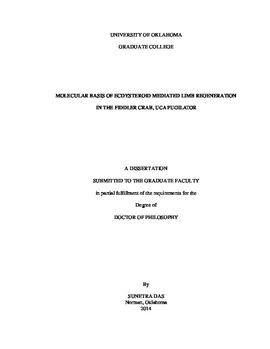| dc.description.abstract | Regeneration is a biological phenomenon that provides an organism the ability to recapitulate part of embryonic development as an adult. The capacity to regenerate is not limited to any particular group of animals; however, invertebrates have greater potential to regenerate lost body parts than vertebrates. The first scientific report of regeneration was a study on crayfish claw and leg regeneration published by the French scientist, René-Antoine Ferchault de Réaumur, in 1712. Efforts to delineate the cellular, molecular, genetic and hormonal basis of regeneration have subsequently been advanced by using model systems like hydra, planaria, salamanders and zebrafish. This dissertation focuses on understanding the hormonal and molecular basis of limb regeneration in a non-model crustacean, the Atlantic sand fiddler crab, Uca pugilator.
Chapter I of this dissertation provides a review of research on limb regeneration in crustaceans and outlines the rationale and focus of the dissertation. The review describes the process of crustacean limb regeneration and its relationship to arthropod growth and molting, and the cyclic changes in circulating hormone (ecdysteroid) titers accompanying this process. Changes in circulating ecdysteroid titers are tightly correlated with the two phases of limb regeneration (basal and proecdysial growth). For the purpose of this dissertation, two different approaches have been taken to study the potential role of ecdysteroid signaling during limb regeneration: a) RNA interference (RNAi) mediated gene knockdown of hormone receptor expression, to investigate any phenotypic consequences of blocking ecdysteroid signaling; and b) a study of global gene expression profiles via next generation sequencing technology (Illumina).
Chapter II addresses the function of ecdysteroid signaling during blastema (basal growth) formation via RNAi-mediated knockdown of ecdysteroid receptors. Knockdown of ecdysteroid receptors resulted in a block in cellular proliferation in the experimental blastemas, absence of the cuticular ingrowths characteristic of the beginnings of limb segmentation, and excessive cuticle deposition. The phenotypic effects on blastemal regenerates induced by RNAi were bilateral and also observed in uninjected limbs in experimental animals. Circulating ecdysteroid levels were also observed to be initially lowered in experimental animals suggesting a systemic effect of receptor knockdown and potential feedback to the Y-organ, the site of ecdysteroid synthesis. These results suggest that although circulating ecdysteroid titers are normally low during basal limb bud growth, signaling via the ecdysteroid receptor pathway is necessary for establishment of blastemal cell proliferation. The receptors may be functioning as repressors in a context of low circulating ecdysteroid; removal of repression could trigger a block in cell proliferation as well as aberrant cuticle synthesis.
Chapter III describes a next generation sequencing approach to study global gene expression profiles in three morphologically distinct stages of limb regeneration as well as in blastemas with disrupted and intact ecdysteroid signaling. RNA-seq analysis generated 848 million short reads produced via the Illumina HiSeq 2000 platform. Following assembly of clean short reads and annotation of contigs, 61,373 non-redundant accession numbers were generated. This represents a major new database resource for crustacean biologists. The dataset has been placed on a web site (http://www.genome.ou.edu/crab_Illumina.html) that is both sequence and keyword searchable.
This database was used to further explore the putative role of ecdysteroid signaling during the regeneration process. As proof of principle, the depth of the sequence analysis has led to the identification of alternate nuclear receptor A/B domain isoforms, which were not identified through previous genomic or cDNA library screenings. Surprisingly, putative orthologs of ecdysteroid biosynthesis enzymes and a putative ortholog of molt inhibiting hormone (MIH), a negative regulator of Y-organ ecdysteroidogenesis, were also identified in the limb regenerate libraries.
The RNAi knockdown phenotypes prompted an examination of genes that could potentially be contributing to the block in cell proliferation. Examination of the relative expression levels of cell division candidate genes between receptor knockdown and control libraries revealed a significant down-regulation of proliferation marker genes like PCNA, MCM2 and the cell cycle regulatory gene CycB in the receptor knockdown library. This was accompanied by a significant up-regulation of the nuclear receptor HR3, which has been shown in insect systems to inhibit CycB expression. Hence, I hypothesize that the block in blastemal cell proliferation in RNAi-treated animals is due to a significant up-regulation of HR3, leading to a lowering of CycB expression and consequent G2/M arrest of blastemal cells.
The excessive cuticle deposition seen in animals with disrupted ecdysteroid signaling suggested an aberrant regulation of cuticular protein synthesis. There was a significant up-regulation of cuticular protein transcripts in the ecdysteroid receptor knockdown libraries when compared to the controls. Interestingly, many of these show an aberrant developmental profile of synthesis; cuticular proteins normally expressed at later stages of the molt cycle are aberrantly expressed in the early blastema.
The lowering of circulating ecdysteroid titers observed as a consequence of receptor knockdown is correlated with a significant increase in MIH mRNA steady state transcripts in experimental animals. We hypothesize that this increase in MIH expression down-regulates ecdysteroid biosynthesis from Y-organs, thereby, further lowering circulating ecdysteroid titers below the critical level needed to maintain blastemal cell proliferation.
To summarize, putative candidate genes that may be mechanistically involved in ecdysteroid-mediated control of cell proliferation, circulating ecdysteroid titer and cuticle deposition during early limb regeneration have been identified. Gene knockdown and global gene expression analysis technologies provided the tools for candidate gene identification in this ‘non-model’ system; these technologies can now also be employed to examine the mechanistic role of these candidate genes in the postulated model. | en_US |
